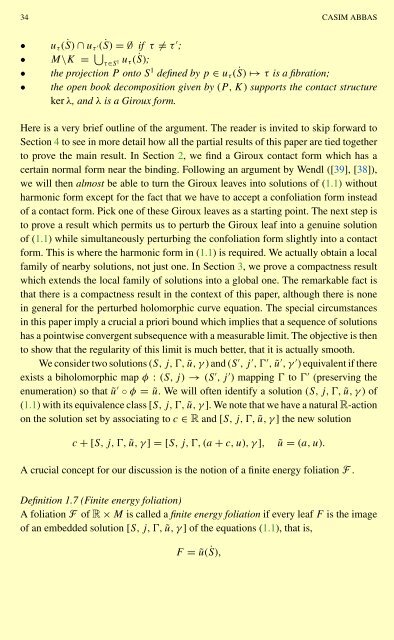NEAR OPTIMAL BOUNDS IN FREIMAN'S THEOREM
NEAR OPTIMAL BOUNDS IN FREIMAN'S THEOREM
NEAR OPTIMAL BOUNDS IN FREIMAN'S THEOREM
You also want an ePaper? Increase the reach of your titles
YUMPU automatically turns print PDFs into web optimized ePapers that Google loves.
34 CASIM ABBAS<br />
• uτ ( ˙S) ∩ uτ ′( ˙S) =∅ if τ = τ ′ ;<br />
• M\K = <br />
τ∈S 1 uτ ( ˙S);<br />
• the projection P onto S 1 defined by p ∈ uτ ( ˙S) ↦→ τ is a fibration;<br />
• the open book decomposition given by (P,K) supports the contact structure<br />
ker λ, and λ is a Giroux form.<br />
Here is a very brief outline of the argument. The reader is invited to skip forward to<br />
Section 4 to see in more detail how all the partial results of this paper are tied together<br />
to prove the main result. In Section 2, we find a Giroux contact form which has a<br />
certain normal form near the binding. Following an argument by Wendl ([39], [38]),<br />
we will then almost be able to turn the Giroux leaves into solutions of (1.1) without<br />
harmonic form except for the fact that we have to accept a confoliation form instead<br />
of a contact form. Pick one of these Giroux leaves as a starting point. The next step is<br />
to prove a result which permits us to perturb the Giroux leaf into a genuine solution<br />
of (1.1) while simultaneously perturbing the confoliation form slightly into a contact<br />
form. This is where the harmonic form in (1.1) is required. We actually obtain a local<br />
family of nearby solutions, not just one. In Section 3, we prove a compactness result<br />
which extends the local family of solutions into a global one. The remarkable fact is<br />
that there is a compactness result in the context of this paper, although there is none<br />
in general for the perturbed holomorphic curve equation. The special circumstances<br />
in this paper imply a crucial a priori bound which implies that a sequence of solutions<br />
has a pointwise convergent subsequence with a measurable limit. The objective is then<br />
to show that the regularity of this limit is much better, that it is actually smooth.<br />
We consider two solutions (S,j,Ɣ,ũ, γ ) and (S ′ ,j ′ ,Ɣ ′ , ũ ′ ,γ ′ ) equivalent if there<br />
exists a biholomorphic map φ :(S,j) → (S ′ ,j ′ ) mapping Ɣ to Ɣ ′ (preserving the<br />
enumeration) so that ũ ′ ◦ φ = ũ. We will often identify a solution (S,j,Ɣ,ũ, γ ) of<br />
(1.1) with its equivalence class [S,j,Ɣ,ũ, γ ].WenotethatwehaveanaturalR-action<br />
on the solution set by associating to c ∈ R and [S,j,Ɣ,ũ, γ ] the new solution<br />
c + [S,j,Ɣ,ũ, γ ] = [S,j,Ɣ,(a + c, u),γ], ũ = (a,u).<br />
A crucial concept for our discussion is the notion of a finite energy foliation F .<br />
Definition 1.7 (Finite energy foliation)<br />
A foliation F of R × M is called a finite energy foliation if every leaf F is the image<br />
of an embedded solution [S,j,Ɣ,ũ, γ ] of the equations (1.1), that is,<br />
F = ũ( ˙S),

















